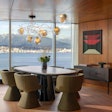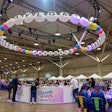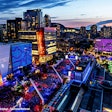
Every year, more than one million people mark the end of summer with a trip to the Canadian National Exhibition, which begins August 21 this year and runs through Labour Day at Exhibition Place. There are close to 5,000 people on hand to run the 18-day event, which includes everything from midway rides to the Canadian International Air Show, a horse show, a food building with close to 100 vendors, and several shopping pavilions. In his 12 years as general manager of the fair—commonly referred to as the C.N.E. or simply the Ex—David Bednar has learned that despite best laid plans, the sheer size of the event means something is sure to go wrong.
What is your primary goal for this year's C.N.E.?
Community celebration. We used to sell the future, and the future is now on Google and other places. You don't go to an exhibition anymore to find out what's new, and it's taken a long time for people to get their heads around that one. That's been a change in terms of exhibitions everywhere, especially large ones.
What's the focus now?
The unique selling proposition for us is the experience. That's a tough sell, but that's basically the business that we're in. We're trying to say, "In exchange for your admission, you'll have an experience that you just can't have anywhere else and that you as a participant kind of self direct, because you choose—in your four or five or six hours at the Exhibition—what you're going to see and do and participate in."
What is your biggest challenge with this event?
The weather. We get ready for this phenomenal party, we plan like crazy, and unfortunately it can get rained out. We try to weatherproof ourselves, but that's a big challenge. The other big challenge is to get people off the couch and out of their house.
Are there any other challenges from a production perspective?
We go from 15 employees to 1,500 employees. I'm sure we're very similar to other events in that regard. It's like having a city on our site every day for 18 days. And so everything from the emergency planning to the safety engineering to the building permits to wrangling the enormous load-in of the exhibitors—it has to go like a military campaign.
How do you measure the success of the C.N.E. each year?
Traditionally in exhibitions it's attendance and surplus or deficit. We've added a family fun index, which is based on behavioural research. We're trying to see if we can [compare] from year to year how much actual fun we're producing. That sounds like an esoteric, crazy concept, but it's based on two valid retail consumer indices plus a question about fun. In terms of attendance, if we could hit 1.5 million, that would be phenomenal. We're budgeted at about 1.3 million people this year.
Has the process for planning the event changed at all this year?
There is an increased emphasis on emergency. We were on the hit list [created by the 17 alleged terrorists accused of plotting to bomb Toronto landmarks in 2006]. We were one of the targets, so we've had to step up security and emergency planning in our run up. We hired a consulting firm to come in and assist us with that. What the public would see is trunk searches and bag searches and that sort of thing, but it's obviously a little bit more in depth than that.
How has the economy impacted the planning this year?
We had a huge debate about that and decided that we were going to go full steam ahead. We based that at least in part on what happened last year. If you go back 12 months, there was all kinds of scary talk about the price of gas—how are we going to get people out to events with this nutty price of gas? Well it actually worked out to our benefit. We had good weather, we had a good program, we had good marketing, but we also had people staying closer to home. There is some evidence to indicate that local attractions do well in recessive economies.
What partnerships are most valuable to the C.N.E.'s success?
The 700 some odd exhibitors and the other 300 or 400 concessionaires are very valuable to us. Those are the steady, stable partnerships. Obviously we've got major sponsorship deals too. The sponsorships that tend to be successful, and I know this is going to sound like it should be self-evident, but the sponsorships that are successful are the ones that want to be here. The ones that simply want impressions, they're just trying to hit a certain number—they tend to come and go. It's not coming here passively, it's coming here actively to do something.
How do you choose exhibitors and vendors every year?
We've got two staff committees that deal with that. We do reject some. We try to take on most, but at a certain point in time when you've got enough [vendors selling] sunglasses or leather belts, you've got to say, "Don't come here because it's not going to be good for your business." But other than that, we're not too picky.
What will you be doing during the event?
You don't know from day to day. I'm in the top position, so I try to make sure I don't have something that I absolutely have to do. But man does the day ever fill up quickly. In some cases I'm wanted for ceremonial type things. One of the things I really enjoy taking part in every year is the citizenship ceremony because I'm a dual citizen [with the United States]. I became a citizen at the C.N.E., so that's kind of a meaningful thing for me.
There's a certain amount of putting out fires, and I'm sure any event planner would tell you that. Despite your best efforts something goes off the rails and it often becomes territorial. In the fair business, as I'm sure at other events, traffic is king. Say you get a dispute between a media outlet that's got a location and a sponsor. Well, now you've got to mediate or negotiate and try and come out of it with a win for both of them, and often times that can be difficult to do.
What have you learned working in this position?
Long-term relationships in this business really matter. People remember. From your customer to your concessionaire to your sponsor, people remember from one year to the next what you did or didn't do for them.



















